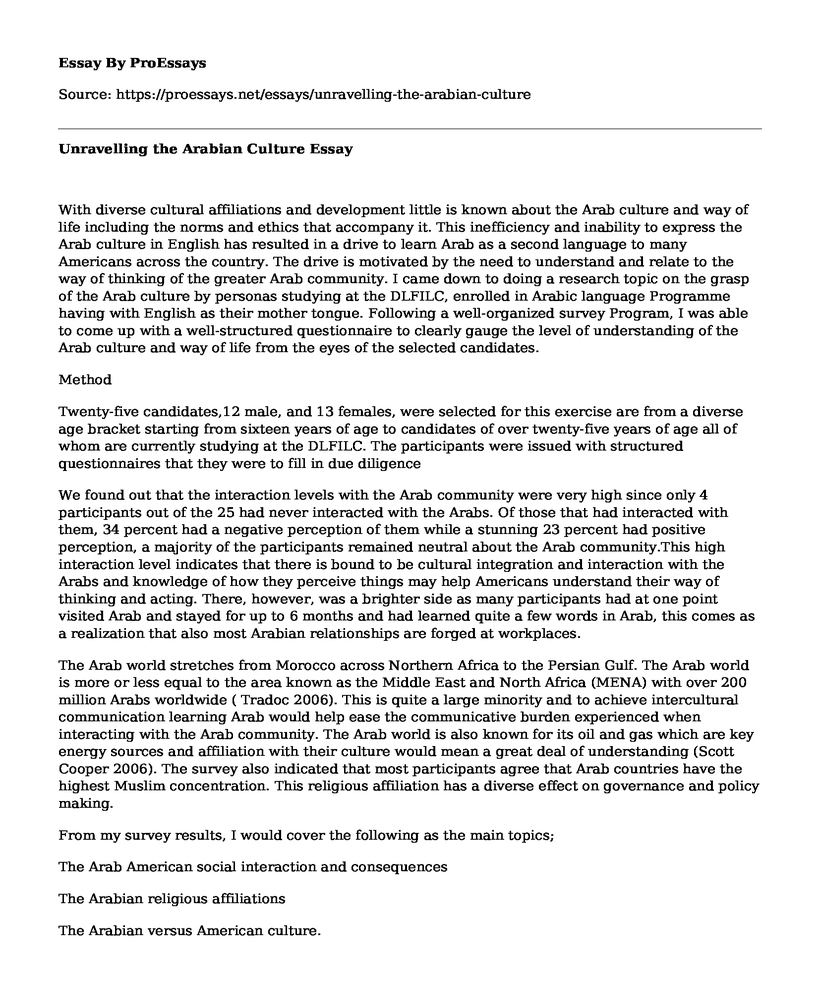With diverse cultural affiliations and development little is known about the Arab culture and way of life including the norms and ethics that accompany it. This inefficiency and inability to express the Arab culture in English has resulted in a drive to learn Arab as a second language to many Americans across the country. The drive is motivated by the need to understand and relate to the way of thinking of the greater Arab community. I came down to doing a research topic on the grasp of the Arab culture by personas studying at the DLFILC, enrolled in Arabic language Programme having with English as their mother tongue. Following a well-organized survey Program, I was able to come up with a well-structured questionnaire to clearly gauge the level of understanding of the Arab culture and way of life from the eyes of the selected candidates.
Method
Twenty-five candidates,12 male, and 13 females, were selected for this exercise are from a diverse age bracket starting from sixteen years of age to candidates of over twenty-five years of age all of whom are currently studying at the DLFILC. The participants were issued with structured questionnaires that they were to fill in due diligence
We found out that the interaction levels with the Arab community were very high since only 4 participants out of the 25 had never interacted with the Arabs. Of those that had interacted with them, 34 percent had a negative perception of them while a stunning 23 percent had positive perception, a majority of the participants remained neutral about the Arab community.This high interaction level indicates that there is bound to be cultural integration and interaction with the Arabs and knowledge of how they perceive things may help Americans understand their way of thinking and acting. There, however, was a brighter side as many participants had at one point visited Arab and stayed for up to 6 months and had learned quite a few words in Arab, this comes as a realization that also most Arabian relationships are forged at workplaces.
The Arab world stretches from Morocco across Northern Africa to the Persian Gulf. The Arab world is more or less equal to the area known as the Middle East and North Africa (MENA) with over 200 million Arabs worldwide ( Tradoc 2006). This is quite a large minority and to achieve intercultural communication learning Arab would help ease the communicative burden experienced when interacting with the Arab community. The Arab world is also known for its oil and gas which are key energy sources and affiliation with their culture would mean a great deal of understanding (Scott Cooper 2006). The survey also indicated that most participants agree that Arab countries have the highest Muslim concentration. This religious affiliation has a diverse effect on governance and policy making.
From my survey results, I would cover the following as the main topics;
The Arab American social interaction and consequences
The Arabian religious affiliations
The Arabian versus American culture.
I would employ the following techniques to enable my academic audience to remember the vital parts of the presentation;
I would ensure their active participation which would include an interactive question and answer session. This would enable the audience to fast track the main points and internalize the presentation. For instance, engaging the audience in a discussion about the findings arrived at in the field.
The use of visual representations such as charts and graphs would come in handy since the visual perception of a theory is easier to remember due to the photographic nature of the representation that intrigues the mind. Presentation using an assortment of photos which are appealing would also help the audience to remember the results and view easily. For instance in our case, a photo of a survey participant engaging in a conversation with an Arab would look appealing to the audience and clearly express that indeed the participants do interact with the Arab community.
In conclusion, Intercultural Communicative Competence as in our case of the Arab community key elements such as tolerance, sensitivity, flexibility and understanding the responsiveness and behavior of the Arabs may come in handy on this quest to learn Arab as a second language.
References
Towards the Rise of Women in the Arab World. (n.d.). Retrieved June 18, 2016, fromhttp://www.arab hdr.org/contents/index.aspx?rid=4
Petraeus, D. H. (2006). Learning counterinsurgency: Observations from soldiering in Iraq. ARMY COMBINED ARMS CENTER FORT LEAVENWORTH KS.
Cooper, A. S. (2011). The oil kings: how the US, Iran, and Saudi Arabia changed the balanceofpower in the Middle East. Simon and Schuster.
Many Arab-Americans Still Perceived As A 'Problem' (n.d.). Retrieved June 18, 2016, fromhttp://www.npr.org/templates/story/story.php?storyId=94502832
Beitin, B. K., & Allen, K. R. (2005). Resilience in Arab American couples after September 11,2001: A systems perspective. Journal of marital and family therapy, 31(3), 251.
Cite this page
Unravelling the Arabian Culture. (2021, Mar 19). Retrieved from https://proessays.net/essays/unravelling-the-arabian-culture
If you are the original author of this essay and no longer wish to have it published on the ProEssays website, please click below to request its removal:
- Causes of High Divorce Rate in the United States Essay
- Essay Sample on The Importance of Accountability and Punctuality
- Essay Example on Latin America's Industrial Revolution: Nationalism, Unlawful Force, and Conflict
- Reforms Impacting Public Sector Unions: Effects on Employees, Employers & Taxpayers - Essay Sample
- Essay Sample on Hitler as Savior: Mjolnir's 1932 German Election Poster
- Culture: Identity, Beliefs, and Day-to-Day Life of a Social Group - Essay Sample
- Conflict Between US Govt & Military: Problems Since Rev War - Essay Sample







